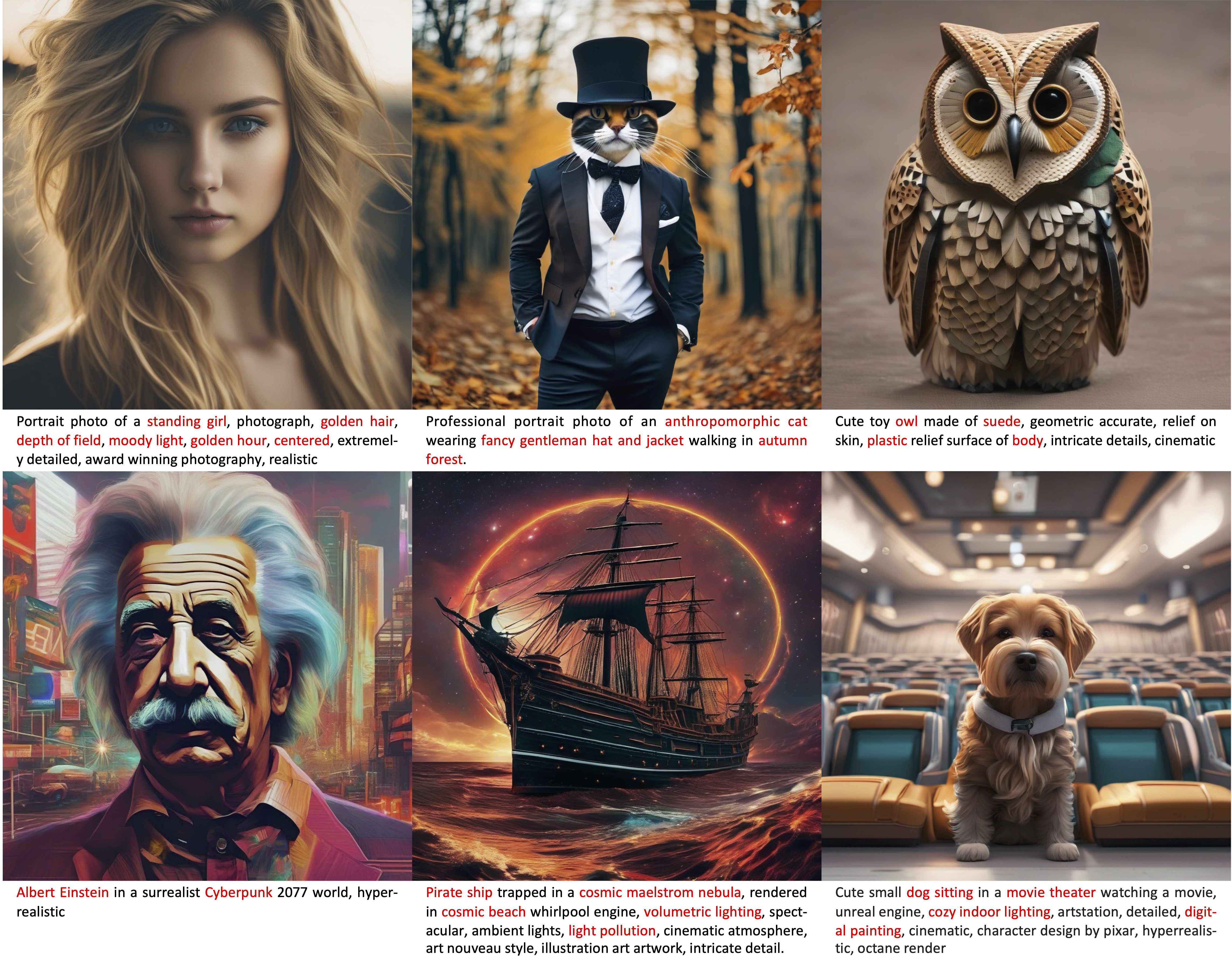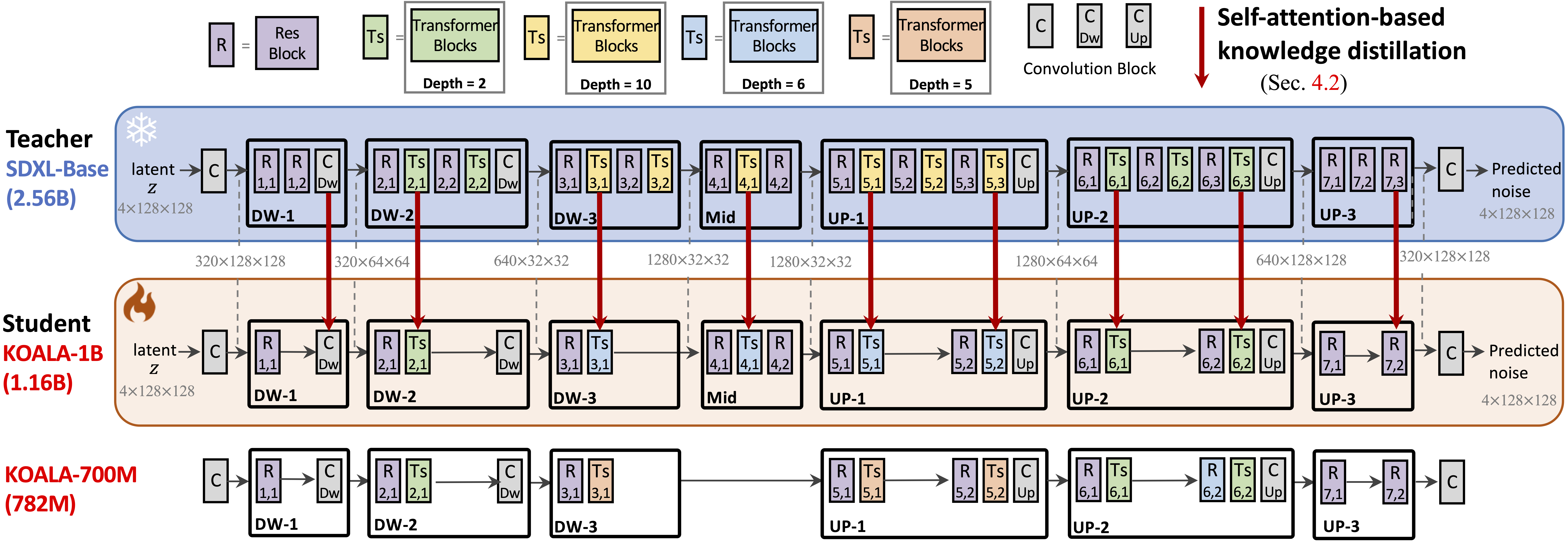tags:
- text-to-image
- KOALA

KOALA-1B-LLaVA-Caption Model Card
KOALA-700M and -1B models originally were trained on LAION-aesthetics-V2 6+ which has some noisy or very short texts. So we construct synthesized captions of LAION-aesthetics-V2 6+ by using a large multimodal model, LLaVA. KOALA-700M-LLaVA-Caption and KOALA-1B-LLaVA-Caption is trained on the synthesized caption-image pairs of LAION-aesthetics-V2 6+.
Abstract
TL;DR
We propose a fast text-to-image model, called KOALA, by compressing SDXL's U-Net and distilling knowledge from SDXL into our model. KOALA-700M can generate a 1024x1024 image in less than 1.5 seconds on an NVIDIA 4090 GPU, which is more than 2x faster than SDXL.
FULL abstract
Stable diffusion is the mainstay of the text-to-image (T2I) synthesis in the community due to its generation performance and open-source nature. Recently, Stable Diffusion XL (SDXL), the successor of stable diffusion, has received a lot of attention due to its significant performance improvements with a higher resolution of 1024x1024 and a larger model. However, its increased computation cost and model size require higher-end hardware (e.g., bigger VRAM GPU) for end-users, incurring higher costs of operation. To address this problem, in this work, we propose an efficient latent diffusion model for text-to-image synthesis obtained by distilling the knowledge of SDXL. To this end, we first perform an in-depth analysis of the denoising U-Net in SDXL, which is the main bottleneck of the model, and then design a more efficient U-Net based on the analysis. Secondly, we explore how to effectively distill the generation capability of SDXL into an efficient U-Net and eventually identify four essential factors, the core of which is that self-attention is the most important part. With our efficient U-Net and self-attention-based knowledge distillation strategy, we build our efficient T2I models, called KOALA-1B &-700M, while reducing the model size up to 54% and 69% of the original SDXL model. In particular, the KOALA-700M is more than twice as fast as SDXL while still retaining a decent generation quality. We hope that due to its balanced speed-performance tradeoff, our KOALA models can serve as a cost-effective alternative to SDXL in resource-constrained environments.These 1024x1024 samples are generated by KOALA-700M with 25 denoising steps.

Architecture
There are two two types of compressed U-Net, KOALA-1B and KOALA-700M, which are realized by reducing residual blocks and transformer blocks.

U-Net comparison
| U-Net | SDM-v2.0 | SDXL-Base-1.0 | KOALA-1B | KOALA-700M |
|---|---|---|---|---|
| Param. | 865M | 2,567M | 1,161M | 782M |
| CKPT size | 3.46GB | 10.3GB | 4.4GB | 3.0GB |
| Tx blocks | [1, 1, 1, 1] | [0, 2, 10] | [0, 2, 6] | [0, 2, 5] |
| Mid block | ✓ | ✓ | ✓ | ✗ |
| Latency | 1.131s | 3.133s | 1.604s | 1.257s |
- Tx menans transformer block and CKPT means the trained checkpoint file.
- We measured latency with FP16-precision, and 25 denoising steps in NVIDIA 4090 GPU (24GB).
- SDM-v2.0 uses 768x768 resolution, while SDXL and KOALA models uses 1024x1024 resolution.
Latency and memory usage comparison on different GPUs
We measure the inference time of SDM-v2.0 with 768x768 resolution and the other models with 1024x1024 using a variety of consumer-grade GPUs: NVIDIA 3060Ti (8GB), 2080Ti (11GB), and 4090 (24GB). We use 25 denoising steps and FP16/FP32 precisions. OOM means Out-of-Memory. Note that SDXL-Base cannot operate in the 8GB-GPU.
Key Features
- Efficient U-Net Architecture: KOALA models use a simplified U-Net architecture that reduces the model size by up to 54% and 69% respectively compared to its predecessor, Stable Diffusion XL (SDXL).
- Self-Attention-Based Knowledge Distillation: The core technique in KOALA focuses on the distillation of self-attention features, which proves crucial for maintaining image generation quality.
Model Description
- Developed by ETRI Visual Intelligence Lab
- Developer: Youngwan Lee, Kwanyong Park, Yoorhim Cho, Young-Ju Lee, Sung Ju Hwang
- Model Description: Latent Diffusion based text-to-image generative model. KOALA models uses the same text encoders as SDXL-Base-1.0 and only replace the denoising U-Net with the compressed U-Nets.
- Training data: LAION-aesthetics-V2 6+
- Resources for more information: Check out KOALA report on arXiv and project page.
Usage with 🤗Diffusers library
The inference code with denoising step 25
import torch
from diffusers import StableDiffusionXLPipeline
pipe = StableDiffusionXLPipeline.from_pretrained("etri-vilab/koala-1b-llava-cap", torch_dtype=torch.float16)
pipe = pipe.to("cuda")
prompt = "A portrait painting of a Golden Retriever like Leonard da Vinci"
negative = "worst quality, low quality, illustration, low resolution"
image = pipe(prompt=prompt, negative_prompt=negative).images[0]
Uses
Direct Use
The model is intended for research purposes only. Possible research areas and tasks include
- Generation of artworks and use in design and other artistic processes.
- Applications in educational or creative tools.
- Research on generative models.
- Safe deployment of models which have the potential to generate harmful content.
- Probing and understanding the limitations and biases of generative models.
- Excluded uses are described below.
Out-of-Scope Use
The model was not trained to be factual or true representations of people or events, and therefore using the model to generate such content is out-of-scope for the abilities of this model.
Limitations and Bias
- Text Rendering: The models face challenges in rendering long, legible text within images.
- Complex Prompts: KOALA sometimes struggles with complex prompts involving multiple attributes.
- Dataset Dependencies: The current limitations are partially attributed to the characteristics of the training dataset (LAION-aesthetics-V2 6+).
Citation
@misc{Lee@koala,
title={KOALA: Self-Attention Matters in Knowledge Distillation of Latent Diffusion Models for Memory-Efficient and Fast Image Synthesis},
author={Youngwan Lee and Kwanyong Park and Yoorhim Cho and Yong-Ju Lee and Sung Ju Hwang},
year={2023},
eprint={2312.04005},
archivePrefix={arXiv},
primaryClass={cs.CV}
}


